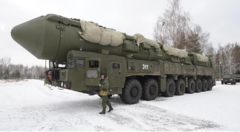Intermediate-range ballistic missile
(missile) | |
|---|---|
 | |
An intermediate-range ballistic missile (IRBM) is a ballistic missile with a range of 3,000–5,500 km (1,864–3,418 miles), between a medium-range ballistic missile (MRBM) and an intercontinental ballistic missile (ICBM). Classifying ballistic missiles by range is done mostly for convenience. In principle there is very little difference between a low-performance ICBM and a high-performance IRBM, because decreasing payload mass can increase the range over the ICBM threshold. The range definition used here follows that of the US Missile Defense Agency.
History
The progenitor for the IRBM was the A4b rocket, winged for increased range and based on the famous V-2, Vergeltung, or "Reprisal", officially called A4, rocket designed by Wernher von Braun. The V-2 was widely used by Nazi Germany at the end of World War II to bomb English and Belgian cities. The A4b was the prototype for the upper stage of the A9/A10 rocket. The goal of the program was to build a missile capable of hitting New York, when launched from France or Spain (see Amerika Bomber).
A4b rockets were tested a few times in December 1944 and January and February 1945. All of these rockets used liquid propellant. The A4b used an inertial guidance system, while the A9 would have been controlled by a pilot. They started from a non-mobile launch pad.
Following World War II, von Braun and other lead Nazi scientists were secretly transferred to the United States, to work directly for the US Army through Operation Paperclip, developing the V-2 into the weapon for the United States.
IRBMs are understood to be operated by the People's Republic of China, India, Israel, North Korea, and Russia. The United States, USSR, Pakistan, United Kingdom, and France were former operators of the IRBM.
Nomenclature
There is no clearly agreed-upon distinction between an intermediate-range and a medium range (MRBM) missile, and the categories overlap. Different sources classify missiles in different ways. They are both distinct from ICBMs, in that they have a range that is less than intercontinental, and hence must be based relatively close to the target. An IRBM, in general, is intended as a strategic weapon, while a MRBM, in general, is intended as a theatre ballistic missile.
Specific IRBMs
Related Document
| Title | Type | Publication date | Author(s) | Description |
|---|---|---|---|---|
| Document:Russia has unveiled a new weapon system as a warning to Ukraine and the West | Article | 21 November 2024 | Scott Ritter | Russia uses its new weapon system – the RS-26 Rubezh hypersonic missile – as a warning to Ukraine and the West |
References
Wikipedia is not affiliated with Wikispooks. Original page source here